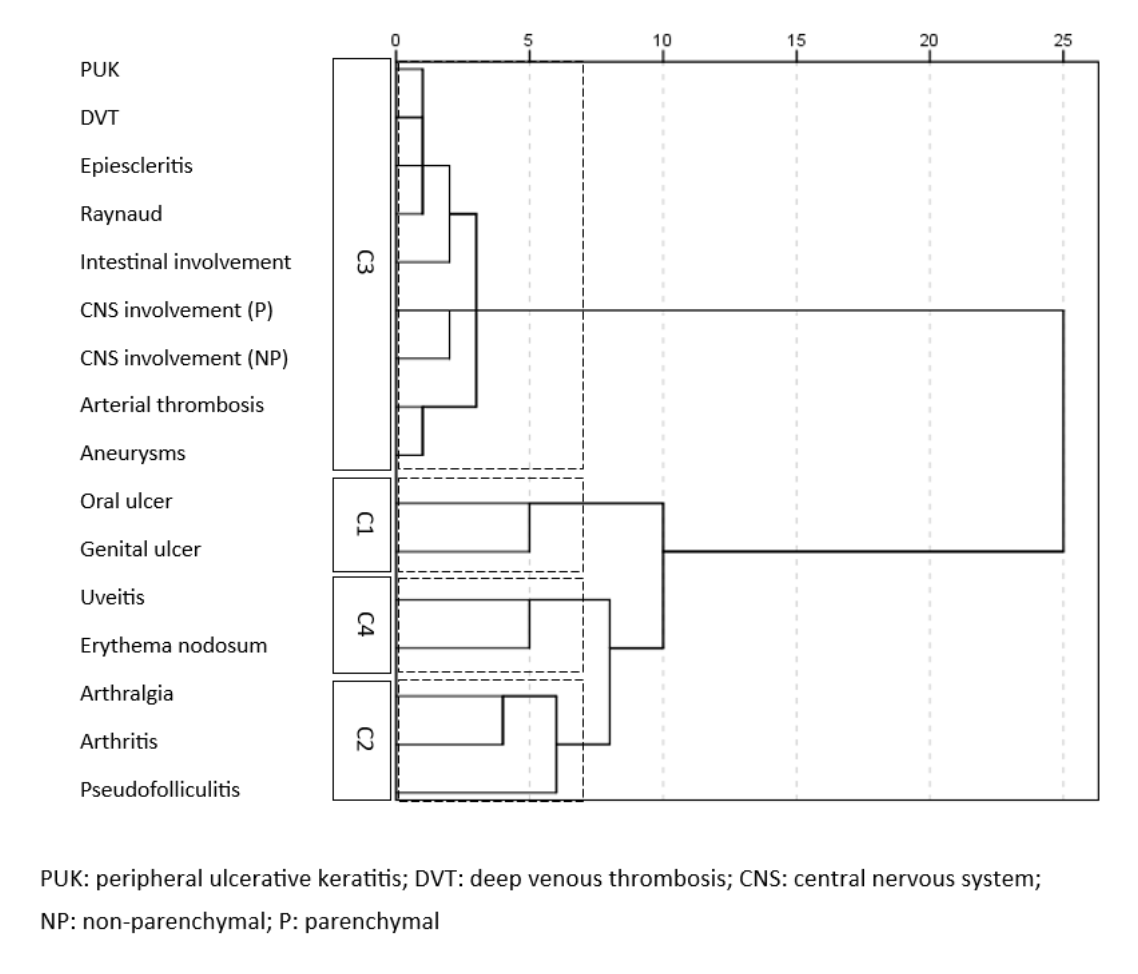Session Information
Date: Monday, November 13, 2023
Title: (1124–1154) Miscellaneous Rheumatic & Inflammatory Diseases Poster II
Session Type: Poster Session B
Session Time: 9:00AM-11:00AM
Background/Purpose: Behcet’s disease (BD) is a variable-vessel vasculitis with a high variability of clinical manifestations. The objective of our study was to identify clinical phenotypes using cluster analysis.
Methods: A model-based clustering relaying on 16 clinical variables was performed in a retrospective cohort of 120 BD patients, diagnosed and follow-up from January 1, 1980 to December 31, 2019 in 3 hospital at Northern Spain (Cantabria). Chi-square test and ANOVA were used to compare categorical and continuous variables among groups. Two-sample t-tests and the partition of Pearson’s chi-square statistic were used in pairwise comparisons.
Results: Cluster analysis identified four groups: C1 (n=47; 39.2%), C2 (n=33; 27.5%), C3 (n=33; 27.5%) and C4 (n=7; 5.8%). The clusters were defined as follows: C1 as mucosal involvement, C2 as joint involvement and pseudofolliculitis, C3 as neurological and vascular involvement and C4 as uveitis and erythema nodosum. There were no baseline demographic differences between clusters and no differences in the application of classification criteria were observed (TABLE 1). The presence of oral ulcers was predominant in all clusters, ranging from 85.7% (C4) to 95-97% (C1-C2), with no significant differences. However, a higher frequency of genital ulcers was observed in C1 compared to the other clusters. Similarly, a significantly higher frequency of erythema nodosum was observed in C4 (85.7%) and of pseudofolliculitis in C2 (93.9%) (p< 0.001). In addition, arterial involvement was more prevalent in C4 (100%, p< 0.001) but there were no differences in venous thrombotic involvement. Aneurysms were only observed in the C4 cluster (FIGURE 2).
Conclusion: We have defined 4 BD phenotypes in our study. This cluster approach may be useful for better patient management due to early identification of clinical patterns.
To cite this abstract in AMA style:
Serrano-Combarro A, Martin-Varillas J, Fernandez-Ramon R, Sanchez-Bilbao L, Alvarez Reguera C, Aurrecoechea E, Blanco R. Identification of Clinical Phenotypes in Behçet’s Disease Using a Cluster Analysis [abstract]. Arthritis Rheumatol. 2023; 75 (suppl 9). https://acrabstracts.org/abstract/identification-of-clinical-phenotypes-in-behcets-disease-using-a-cluster-analysis/. Accessed .« Back to ACR Convergence 2023
ACR Meeting Abstracts - https://acrabstracts.org/abstract/identification-of-clinical-phenotypes-in-behcets-disease-using-a-cluster-analysis/


